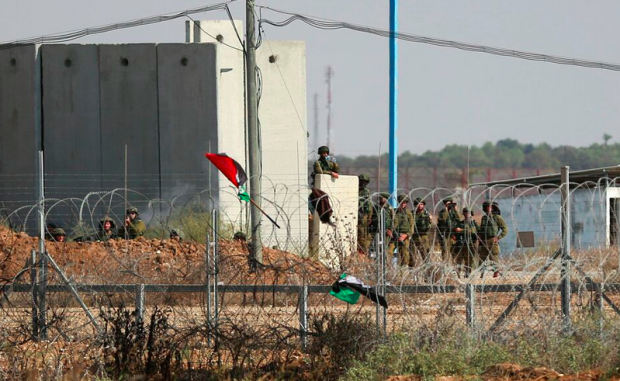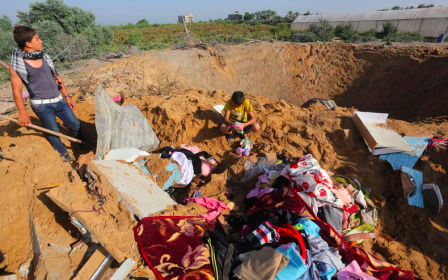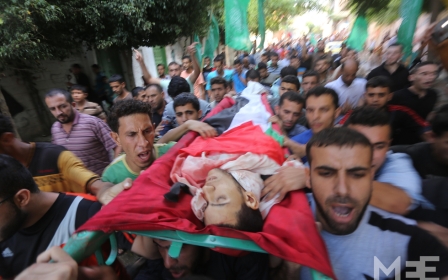Gaza protests: 'Each time we heard a bullet, a protester fell'

UPDATE: A day after this report was published, Israel’s Channel Two news reported that Israeli army acknowledged that its unit has used aggressive force in Gaza and announced that the border troops would be recalled and replaced by fresh units. Only rubber bullets and tear gas are now being used, the report added.
GAZA CITY – The last few days have been bloody ones for Gaza, with 11 protesters, largely boys and youths, shot dead by Israeli forces near the border. More than 200 have been injured, the Gaza Health Ministry said.
With tensions boiling over in the West Bank and Jerusalem, on Friday hundreds of people gathered near the border fence with Israel east of Gaza City close to Shejayeh, east Khan Younis and north of Gaza Strip close to Erez crossing point. They chanted, jostled and threw rocks but the Israelis responded with live ammunition. Six youths died at the scene and one succumbed to his wounds the day after. More than 130 people were injured.
Despite the deaths, the next day protesters once again gathered near the border. In Khan Younis in the southern Gaza Strip, 13-year-old Marwan Barbakh and 15-year-old Omar Othman were shot and killed by live ammunition.
An Israeli army spokesperson said around 200 Palestinians had approached the fence while hurling rocks and rolling burning tires toward security forces.
"Forces on the site responded with fire toward the main instigators to prevent their progress and disperse the riot," she said.
The protesters have today returned once more but their numbers are fewer, and the mood increasingly sour. Most openly talk about how the rules of the game have changed, and how protesters appear to have become fair game. Young people who survived the weekend’s mass shooting on the border said that during many clashes in Khan Younis, Israeli troops opened fire at short distance with live ammunition.
A young man, who drove a badly injured 18-year-old Palestinian protester to the hospital on his motorbike on Friday, said he was shocked at what he witnessed. As he spoke another motorbike came in carrying a dead youth.
“Usually when we protest, the Israeli troops issue warning shots first,” the teenager, who did not want to give his name, told MEE.
“This time, the soldiers are shooting directly, and each time we heard a bullet, a protester fell,” he said as he watched his friend’s body being transferred from the motorcycle into an ambulance nearby.
Several Palestinian journalists confirmed the phenomena, saying that they believed live bullets were fired at specific targets.
A survivor of Friday's protests, 18-year-old Jihad Mohsen, told MEE he was standing right next to fellow youths as they were gunned down and killed.
He said there were about 30 people on the frontline, close to the fence, just tens of meters away from Israeli troops who stood sheltered behind some man-made sand barriers, dug out for protection by Israeli bulldozers.
“We were carrying our Palestinian flags, and throwing stones in retaliation, and suddenly the live ammunition was directly hitting us, at which point [19-year-old] Mohammed al-Reqeb was shot,” Mohsen said.
“There was no occasion where a bullet was fired without someone being hit and falling - it was deliberate, they were aiming directly at us,” he told MEE.
Medical staff treating the wounded at Khan Younis’s European Hospital told MEE that they were shocked at the numbers of victims with precise bullet wounds, which they say appeared to be deliberately aimed not to injure, but to kill or cause the maximum amount of damage.
An on-duty doctor at the hospital reception said he felt the injuries were “designed” to create patients with long-term disabilities.
Another doctor at Gaza European hospital who is not authorised to speak by his ministry, told MEE that some of the wounds were from snipers, who knew exactly what part of the body to hit, to kill instantly.
He said that these kinds of injuries were rare and that Gaza medical crews were more accustomed to receiving patients with “indiscriminate wounds” that were caused by shelling or Israeli air strikes.
Overnight on Saturday, a pregnant woman was killed along with her three-year-old daughter after Israeli rockets levelled a house close to Gaza City, in the latest such incident to rock the Strip. Israeli authorities say they were targeting Hamas positions and weapons stockpiles. Palestinians say there were no rockets, but claim that there was a Hamas military training camp nearby.
Shoot to kill
Deputy Health Minister Dr Medhat Mouhsen said many of the wounded were hit in the head and the upper body.
He accused Israeli soldiers of using explosive bullets, which maximise fatal damage upon impact.
“Israeli soldiers are deliberately using a criminal doctrine policy, of shooting directly, with the aim to kill.”
“It is time for human rights groups on both local and international levels - especially The Committee of International Red Cross - to expose these crimes,” he said.
The Geneva-based Euro-Med Human Rights Monitors also said that it had evidence that Israeli troops patrolling the border were deliberately targeted protesters.
“We have collected evidence based on eyewitness accounts that shootings took place from short-distance range and live ammunition was used against the border-fence protesters,” said Ramy Abdu, the chairman of the Euro-Med Human Rights Monitor.
In some cases, which were reported by protesters and medical staff, rubber-coated steel bullets were also used, the organisation said.
As another ambulance arrived at the hospital and bodies were carried in, a young man stood by covered in blood. He told MEE how he had tried to rescue one of the wounded protesters on Friday - Adnan Moussa Abu Elian - who didn’t survive.
“Just before Adnan fell, we heard a couple of shots, and immediately he fell with an injury to his head,” the man said, speaking on the condition of anonymity. “[As this happened] another young man nearby was hit in his upper right arm.”
In another part of the Gaza Strip where smaller protests took place, few eyewitnesses and doctors have come forward as of yet to verify the practice, but concerns have been growing for some time that shooting to kill might be the new norm.
In May, Israeli campaign group Breaking the Silence interviewed more than 60 members of the Israeli army, air force and navy, including soldiers and officers who confirmed deliberate shootings of Palestinian civilians.
The result of the investigation, largely based on events during last summer’s 51-day war in Gaza, alleged that Israel’s military deliberately pounded civilian areas of the Gaza Strip with incessant fire of indiscriminate ordinance, and took little care to avoid civilians. The Israeli authorities have repeatedly denied this and insist that they do everything in their power to warn civilians and to avoid casualties, instead blaming Hamas for hiding weapons and fighters amidst civilian structures.
With the Strip on edge and the largely young and leaderless protests continuing – few of the young protesters identify as either Hamas or Fatah – the Gaza health ministry says it is taking no chances. It says it will devote all available resources to keeping the country’s emergency departments and hospitals open to the deal with any new casualties.
New MEE newsletter: Jerusalem Dispatch
Sign up to get the latest insights and analysis on Israel-Palestine, alongside Turkey Unpacked and other MEE newsletters
Middle East Eye delivers independent and unrivalled coverage and analysis of the Middle East, North Africa and beyond. To learn more about republishing this content and the associated fees, please fill out this form. More about MEE can be found here.





